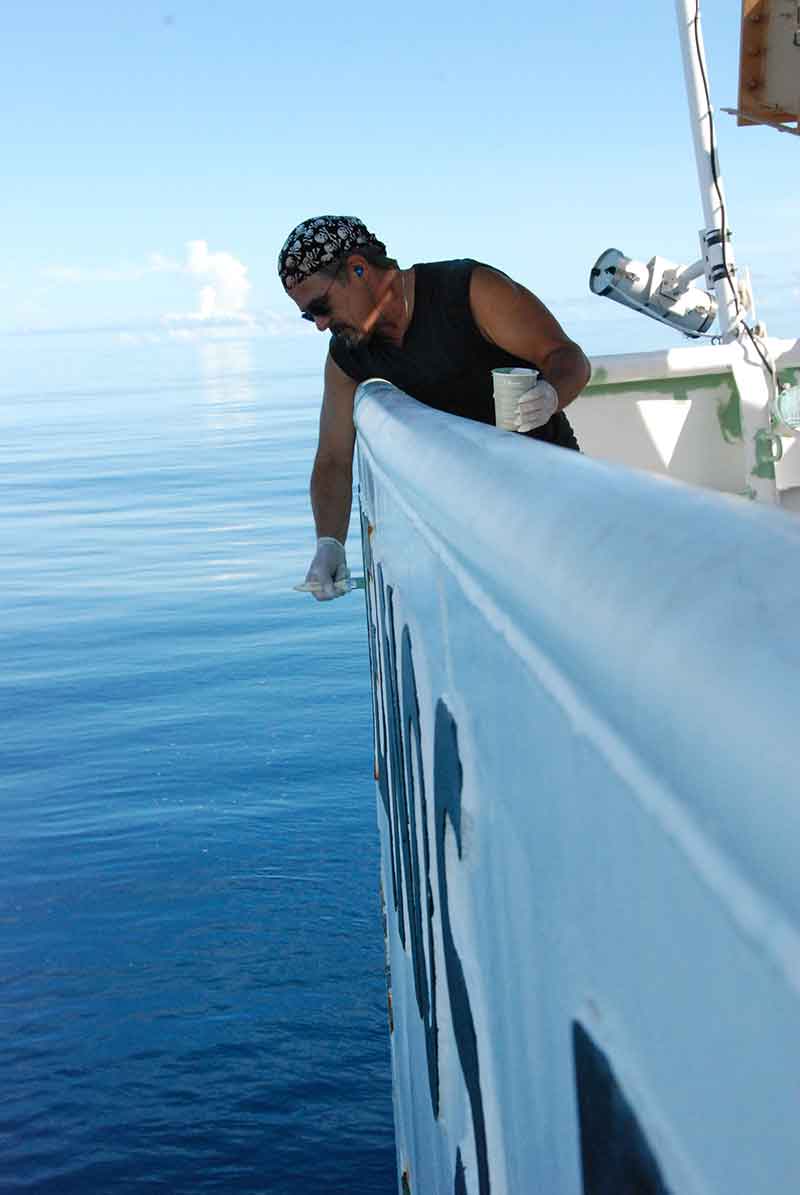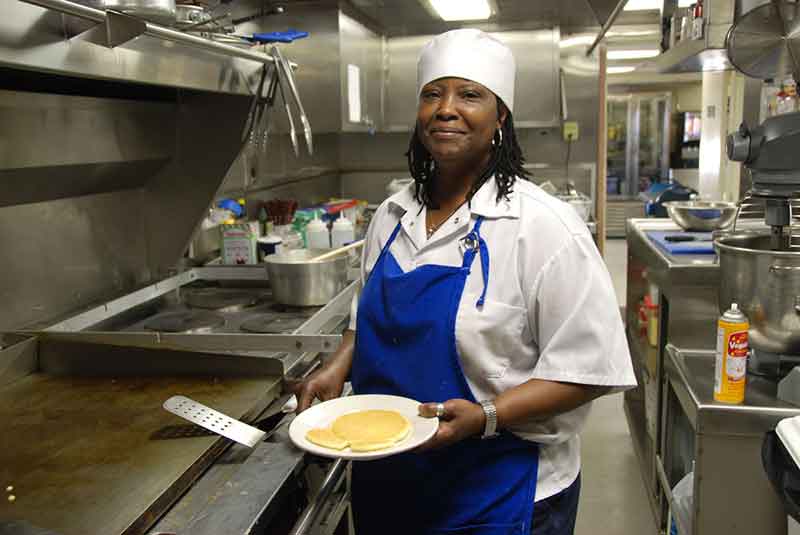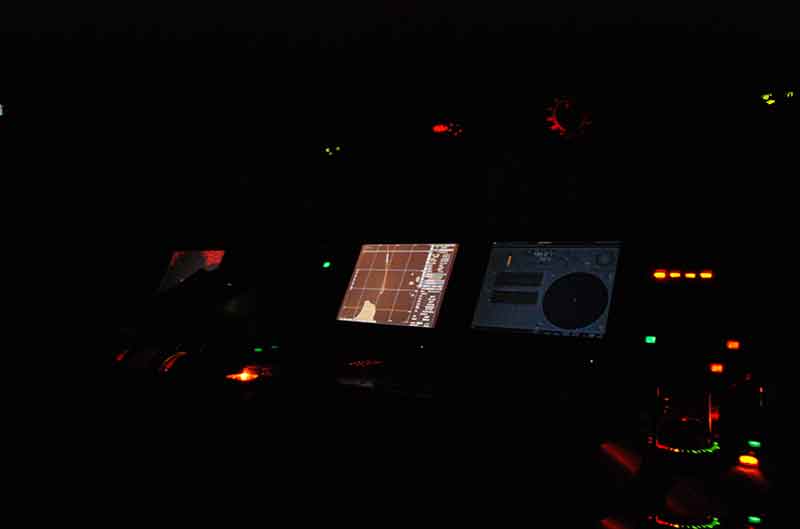
by Colleen Peters, Senior Survey Technician
July 29, 2010
The mapping, Conductivity Temperature Depth (CTD) sampling, and remotely operated vehicle (ROV) dives would not be possible without the ship’s crew to maintain the platform from which we explore the ocean. Here is a brief look at what a typical day is like on NOAA ship Okeanos Explorer while the ship is underway and conducting operations. Not everyone is directly involved in the mission activities on a daily basis, but everyone on the ship has a very important role in the success of the mission.

ENS Benjamin Bloss writes in one of the many logs that the bridge officers must update during their watches. These include the deck, VHF, GMDSS, compass, trash, and weather logs. Image courtesy of the NOAA Office of Ocean Exploration and Research, INDEX-SATAL 2010. Download larger version (jpg, 3.2 MB).

General vessel assistant Jack Standfast primes rust spots on the bulwarks of the aft deck in preparation for painting them white to blend in with the rest of the hull. This is a typical task for members of the deck department, who maintain the outer decks and structures of the ship. Image courtesy of the NOAA Office of Ocean Exploration and Research, INDEX-SATAL 2010. Download larger version (jpg, 4.2 MB).
Midnight: Start of the new day on Okeanos time. Mapping watches in effect. Two mapping watchstanders, officer of the deck, lookout, and scientist on duty. The lookout makes security rounds each hour until 0700 to make sure that there are no signs of fire, flooding, or other emergencies. Science updates are also given via the intercom system at the top of every hour. The officer of the deck manually records weather observations every hour in a written log (basic information for ship’s records) and big weather (a much larger data set for weather service) in electronic form every six hours on the 12s and 6s of UTC (Universal Time Coordinated) time. Mapping watchstanders acquire and process multibeam data.
0030: Mapping team conducts XBT cast.
0330: Bridge watch turnover, science turnover.
0345: Lookout watch turnover.
0400: Survey watch turnover.
0540: Sunrise.
0600: Galley and engineering departments' workday begins. Galley begins breakfast preparations and clean up from overnight use. Engineering daily rounds commence, including: testing of potable water and addition of bleach, back flush of the MSD book cell, adding evaporator treatment chemicals, blowing down air receivers for compressed air, checking engine oil, and completing an engine space round (the round includes filling out a log with readings from all of the gauges in all of the engineering spaces). Medical officer opens sick bay, turns on and checks all equipment in the ship’s hospital as well as checks the ice box temperature (which houses a number of prescriptions and other medical equipment).
0630: Commanding Officer (CO) reviews daily weather report and forecast. Engineering secures overboard discharges.
0700-0800: Breakfast served.

Chief cook Doretha Mackey works long and grueling days in the loud, heated galley, preparing three meals a day as well as snacks and desserts. A must have is her Coca-Cola cake! Image courtesy of the NOAA Office of Ocean Exploration and Research, INDEX-SATAL 2010. Download larger version (jpg, 428 KB).
0700: Chief electronics technician (ET) checks the network connections to verify it is working properly. The ETs also check the VSAT signal, the emergency radio configurations, and radio power status; look for error messages; check the ship’s camera feeds; and confirm that the email server is receiving/sending email accordingly.
0730: Bridge watch turnover, bow and stern thrusters online. Deck department day workers begin workday with morning meeting; science watch turnover; engineer on call (EOC) turnover (each licensed assistant engineer is "on call" and responsible for alarms and other engineering problems encountered during the day or after hours).
0745: Lookout watch turnover. Safety meeting: The CO meets with department heads to go over the daily weather report and safety-related items regarding the day’s operations.
0800: Mapping lead completes preliminary quality check on overnight multibeam data and creates daily mapping products to be transferred by the ship’s FTP site to shore so that the Exploration Command Center (ECC) scientists can have them in hand for the 0900 meeting.
0815: Mapping operations secured; officer of the deck, deck department, and ROV team on deck and in the control room to deploy ROV.
0900: Medical conducts daily round of galley spaces for sanitation check.
0900-1000: Galley closed for cleaning.
0930: Galley begins lunch prep.
1000-1015: Morning break for ship’s crew.
1000-1030: Average time that the ROV reaches the bottom (this is dependent on the depth of the dive site and will be earlier if shallower, later if deeper).
1100-1230: Lunch served in shifts, as mess deck seating cannot accommodate everyone at the same time: watchstanders from 1100-1130; ship’s crew from 1130-1200; mission personnel from 1200-1230.
1130: Bridge watch turnover, science turnover.
1145: Lookout watch turnover.
1155: Officer of the deck tests ship’s radio equipment and switches steering pumps.
1200: Officer of the deck tests the ship’s whistle and general alarm. Engineer completes engine space round.
1230-1330: After-lunch galley cleanup.
1400-1415: Afternoon break for ship’s crew; ship’s store open.

Third assistant engineers Greg Feeney (back) and Tim VanDyke (front) fabricate parts for the ship’s infrastructure. Image courtesy of the NOAA Office of Ocean Exploration and Research, INDEX-SATAL 2010. Download larger version (jpg, 939 KB).
1500: Operations brief: department heads meet to discuss the day’s events, problems, concerns, and plans for the following day. Galley washes ship’s linens, completes maintenance on any galley spaces, stocks up, finishes additional cleanup and trash disposal. Engineer completes engine space round.
1515: Mapping lead completes line plan for the evening mapping operations. CO and Operations Officer review the line plan in the dynamic positioning system for the evening and plan of the day (POD) for following day.
1530: Bridge watch turnover, science turnover; average end of the dive.
1545: Lookout watch turnover.
1600: Survey watches begin, deck-department day workers' workday ends, galley prep for dinner.
1630: CO reviews fuel consumption and tank soundings for stability between fuel tanks and ballast tanks. First assistant engineer completes daily engineering work log to document the work completed throughout the day.
1700: ROV recovered.
1700-1800: Dinner served.
1700-1730: Chow relief for watchstanders on bridge.
1730: Underway, resume mapping.
1759: Sunset.
1800: Ship’s store open; crew gaming or movie time in the lounge.

Once your eyes adjust, this is what the bridge looks like while the ship is navigating at night. The screens, buttons, and gauges are all dimmed at dusk so that the watchstanders can maintain their night vision to keep a lookout on the horizon for oncoming traffic or other obstacles. Image courtesy of the NOAA Office of Ocean Exploration and Research, INDEX-SATAL 2010. Download larger version (jpg, 2.9 MB).
1900: Galley department finished for the day after dinner clean up. CO writes night orders for the bridge watch, including any specific instructions regarding operations, the navigational area, and/or any safety concerns.
1945: Lookout watch turnover.
2000: Survey watch turnover.
2200: Video engineer finishes processing video from the day’s dive.
2300: Telepresence lead makes quality check of video and imagery processing, verifies that it is complete, performs data back up, and starts rendering clips.
2330: Bridge watch turnover.
Some of these tasks are not glamorous, but they are required for the safety of the ship, crew, and equipment. This is an average day – which doesn’t include the CO being called multiple times during the night for vessel traffic or the breakdown of equipment and man-hours involved in troubleshooting and fixing it, nor does it include the loss of sleep by engineers being called out to attend to alarms in the middle of the night.
This doesn’t include weekly fire and emergency and abandon ship drills, command inspections, or weekly and monthly maintenance procedures. We may always have a plan for the day, but oftentimes things change.
The only thing we can really count on is that tomorrow will still feel like Tuesday.